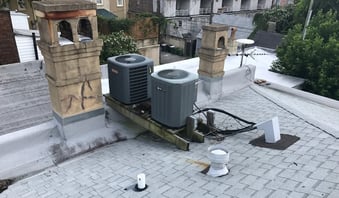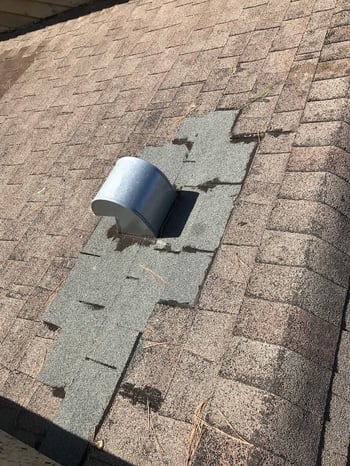
Have you ever gazed at your home's roof and been intrigued by a peculiar spinning fixture perched on top? If so, congratulations! You've just stumbled upon your whirlybird roofing ventilation system. The good news is that you do have a ventilation system in place. However, if you've found yourself wondering, "Why don't I have that?" then you might fall into one of two categories. You either A: don't have a roof ventilation system, or B: possess a different type of system that isn't as conspicuous as the whirlybird.
Ventilation system? Whirlybird? We know, this probably sounds like absolute gibberish. Bare with us as we explain all of the different types of roof vent systems! At RoofCrafters, we’ve been installing and repairing vent systems on residential roofs for nearly 30 years, so it’s safe to say that we’ve got a knack for this sort of thing. And more than anything, we want you to be equipped with the knowledge you need to make informed decisions.
If you landed here, you’re probably wondering what you need to know about roofing ventilation systems. The good news is you've made it to the right place! Here, we'll explain what a roofing ventilation system is, the different types of vents on the market (that RoofCrafters installs), and why they’re important to have. Let’s delve right in!
What is a Roof Ventilation System?
Roofing ventilation systems operate on a simple yet vital principle: warm air rises. As we navigate our lives on Earth, this phenomenon manifests itself everywhere. Within your home, the same concept comes into play, leading to temperature variations of different levels. For instance, basements typically remain cooler, while upstairs rooms and attics tend to be warmer.
During scorching summer months, the sun's rays cause the air in your attic to heat up dramatically. In response, your home's air conditioning system works to cool this hot air down, maintaining a comfortable indoor environment. Conversely, in winter, the cool air trapped in the attic gets heated by the warmth emanating from your home's interior, creating a balanced temperature.

Proper roofing ventilation plays a critical role in managing these temperature fluctuations, ensuring efficient airflow, and maintaining a comfortable and energy-efficient living space throughout the year. In this article, we will delve deeper into the significance of roofing ventilation, exploring its impact on indoor comfort, energy consumption, and the overall health of your home.
Regardless of the season, a well-functioning ventilation system plays a crucial role in maintaining a comfortable indoor environment.
Whether it's the refreshing coolness of natural outdoor air or the conditioned air from your AC, a good ventilation system ensures that this cool air enters the attic near the eaves, which are the edges or overhangs of your roof, and exits near the peak. Traditionally, some vents are strategically placed lower, while others are positioned higher to facilitate the most effective airflow.
The ultimate goal of this ventilation system is to create a balance, ensuring that the temperature and humidity levels inside the attic align with those outside. This equilibrium not only benefits your entire home but also extends to the well-being of your cherished belongings stored in the attic.
Just picture the thought of Grandma Carol's treasured 80-year-old angel figurines tucked away, safe and cool, even during the heat of August. The longevity and preservation of your valued possessions depend on the proper regulation of temperature and humidity within the attic space, and a well-designed ventilation system can be your home's secret to achieving just that.
The Different Types of Roof Vents Defined
There are many different types of roofing ventilation systems on the market. The vents that RoofCrafters works with specifically are called:
 Ridge vents. These vents are installed on the peak of a roof. They help to provide continuous and uniform exhaust ventilation at the highest portion of the attic and are designed to help resist heavy and wind-driven rain.
Ridge vents. These vents are installed on the peak of a roof. They help to provide continuous and uniform exhaust ventilation at the highest portion of the attic and are designed to help resist heavy and wind-driven rain.- Off ridge vents. Off ridge vents are not only UV-resistant, but they’re a static system as well. This type of system is suitable for installation on sloped roofs.
- Gable vents. Gable vents are usually installed on the exterior wall of your attic, and unlike the other venting systems, they’re meant to be seen. They add an architectural element to your home and create the proper air circulation needed.
- Mechanical vents. As the example of the whirlybird that was mentioned above, mechanical vents use the power of the wind to help remove excess heat and moisture from your attic.
- Power vents. Power vents use your homes electricity to power the fan. Or solar power fans are available to provide the attic circulation and ventilation needed.
Whether you already have a ventilation system in place or are considering installing one in the future, the type of roof you have and the square footage of your attic will be pivotal factors in determining the most suitable option. Entrust this decision to a professional roofing contractor who will conduct a comprehensive assessment of your attic and roof. Their expertise will guide you towards the ultimate choice that meets your home's specific ventilation needs.
Alternatively, you can utilize the GAF ridge vent calculator, a useful tool that will help you calculate the ideal amount of ventilation required for your house. Embrace the flexibility of customized ventilation solutions, tailored to optimize the comfort and health of your home.
Why is a Ventilation System Important?
Not only are vent systems mandatory for the sake of warranties, but they’re also vital for several different reasons that include:
Roof Longevity
Without a doubt, a properly functioning ventilation system is a crucial factor in ensuring the longevity of your roof. Its significance cannot be overstated. If you have asphalt shingles on your roof but neglect to install a ventilation system alongside it, you might find that your roof's lifespan falls drastically short of the expected 15 to 20 years. Emphasizing the importance of ventilation is crucial to safeguarding your roofing investment and ensuring a durable and long-lasting roof for your property.
Without proper ventilation, your attic will become so hot during the summer months that your shingles will literally begin to cook. Not only will you have to dish out more money for a new roof installation, but this could potentially start a fire. Homeowner’s insurance will not cover these costs, as this would fall under neglect.
Heating and Cooling
Just like you and I need to breathe to stay comfortable, your roof and attic require the same! Under the scorching heat and relentless sunlight, your attic can become an unbearable space. Grandma Carol's figurines can attest to this. When your attic lacks proper ventilation, the hot air accumulates over time, creating an unpleasant and potentially damaging environment.
To establish a healthy airflow within your attic, think of it as an inhale and exhale process. Cooler air should enter your attic through vents, pushing the warm air out as if taking a breath. This balanced ventilation ensures your attic can "breathe" effectively, keeping your home comfortable and protecting your treasured belongings.
With proper ventilation, not only will your attic space remain at a moderate temperature, but so will your entire home! When the temperature is controlled, you’ll be at a lesser risk of trapped moisture and everyone’s least favorite, roof leaks.
Cost Efficiency
That’s right, proper ventilation is cost-efficient. Although it’s a bigger investment upfront, it will pay off in the long run, we promise. With a vent system, you won’t have to worry about paying as much on energy bills, as your attic would be leaking hot air throughout the rest of your home. Sayonara, hefty utility bills!
Not only will your AC not have to work as hard, but you’ll be saving the money you’d have to spend on attic and roof repairs if you didn’t have a ventilation system installed. All in all, save yourself stress and money and make sure your home has the proper ventilation system installed.
Should I Invest in a Roof Ventilation System?
Consider it a magical prediction from the all-knowing Magic 8-ball – proper roof ventilation is undeniably essential. To recap the benefits, installing vents will not only save you money, but it will also extend the lifespan of your roof, providing years of reliable service.
Moreover, your entire home will enjoy consistent temperature control, ensuring optimal comfort throughout the seasons. At RoofCrafters, we understand that investing in vents may seem like a larger upfront expense, but we can assure you that the long-term benefits make it truly worthwhile. Trust in the power of ventilation to enhance your home's well-being and bring you lasting peace of mind.
As you embarked on reading this article, you might not have known quite what to expect, unless, of course, you happen to be a roof-vent-guru – in which case, welcome and thank you for joining us! For those who aren't roofing experts, you may now find a sense of relief knowing that your roof ventilation system is diligently at work, ensuring a comfortable and well-regulated environment within your home.
If you find yourself feeling even more concerned after reading this article because your roof lacks a properly functioning ventilation system or one altogether, there's no need to panic! Take a deep breath and drop us a line. One of our friendly experts will reach out to you to schedule an inspection as soon as possible. In the meantime, check out our article on roof ventilation basics.
My name is Kevin Mills, and I am the lead estimator for RoofCrafters’ Tampa division. I’m originally from Michigan, and I enjoy hunting, fishing, and spending any free time outdoors. What I’m most passionate about, though, is helping business owners and homeowners alike achieve their roofing goals, all while providing a seamless customer journey.




